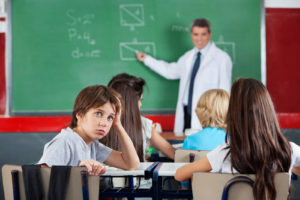
Can Vision Therapy Help Children with Math Problems?
Proficient math skills are a necessity of everyday life and an essential part of any child’s development. Without good basic math skills, adult life has the potential to be more difficult than it needs to be. Unfortunately, the percentage of people with lower-than-average math skills is very high in the United States and this has recently been connected to vision problems. However, there’s something called vision therapy that might be able to help.
Most vision problems associated with poor math skills are often undetectable in a routine vision screening. The American Optometric Association says that nearly 25 percent of children have vision problems that are undiagnosed. These include amblyopia (lazy eye), eye teaming, poor depth perception, and convergence insufficiency.
How Does Poor Vision Affect Math Skills?
 When a child has poor vision, he or she might have difficulty seeing the numbers clearly. They might not be able to distinguish between decimal points and symbols used in math. Moreover, one of the most important skills in math is to organize numbers and letters in a certain way. If a child’s vision is poor, they can have problems keeping these numbers and letters in the correct place.
When a child has poor vision, he or she might have difficulty seeing the numbers clearly. They might not be able to distinguish between decimal points and symbols used in math. Moreover, one of the most important skills in math is to organize numbers and letters in a certain way. If a child’s vision is poor, they can have problems keeping these numbers and letters in the correct place.
Furthermore, directionality and laterality are also important concepts in math. If the child can’t see the number’s orientation clearly, they will have more difficulty than a child who can.
It doesn’t necessarily mean that a child won’t be any good at math. However, it has been found that those who lack the necessary vision skills take longer to find the answer to a math problem. This has proven to severely hinder them during timed tests.
What Do the Professionals Say?
Connecting vision and learning difficulties has become a popular area of study for researchers and specialists in the field all across the globe. Researchers in Sudan conducted a study that examined the impacts of multiple eye conditions on student academic performance. They found that, resoundingly, students with poor vision did worse in school than children with normal vision. So, what can be done to help your students achieve more academically if they suffer from vision issues?
The Optometrists Network found that implementing vision therapy helped children improve math skills in several ways. From helping students improve their eye tracking to correcting double vision, they share a number of success stories that demonstrate the benefits of vision therapy.
If somebody can’t see clearly, they will have difficulty with subitizing, and simple tasks such as counting will become even more difficult. By improving vision skills, subitizing will improve, and consequently, math skills will improve.
How Can Vision Therapy Help?
Now that we know that poor vision is associated with math problems, let’s talk about how you can help improve your child’s eyesight with vision therapy. These exercises are mainly focused on children, but adults will be able to get some benefit from them, too.
Amblyopia
Amblyopia is known as a lazy eye syndrome and can be treated with exercises if you catch it early enough. The lazier eye is weaker than the other stronger eye. Therefore, putting a patch over the stronger eye ensures that the weaker one is being used all the time. This will force the eye to get stronger because it’s relied upon for vision.
When the patch is on, do activities that involve a need for good vision. That could include simple sports like throwing a ball or it could include arts and crafts. These vision therapy activities force the eye to focus on various colors, shapes, and moving objects; it will become stronger the more it’s exercised.
Eye Teaming
Eye teaming is where the two eyes work together as a single entity and not two separate functions.
The best practice for teaming up your eyes is to force yourself to cross them. Put your finger up at arms-length and focus on the finger whilst slowly moving it towards the center of your eyes. Then look away and focus on something far away. Repeat this process for a few minutes or until your eyes are strained.
Once you have done this, download and print some 3D photographs. This is known as stereopsis. There are two images that are very similar. When you look at them with crossed eyes, you force yourself to see one image which will appear to be in 3D! This is great for kids and adults alike.
Depth Perception
Depth perception is where your eyes calculate how far away an object is. There are many exercises that can help improve depth perception. A helpful and fun exercise for children involves a brightly colored moving object. Attach a beach ball to some string and then hang it around two to three feet from the ceiling.
Then hit the ball in the same direction and keep your focus on it. The beach ball will be moving from left to right and closer and farther at the same time. This will help children to improve their depth perception and it can be pretty fun at the same time!
Convergence Insufficiency
Convergence insufficiency is a weakness of the muscles that coordinate the eyes’ focus on objects at close distances. You need an exercise that strengthens these muscles to improve your vision.
Hold a pen at arm’s length and keep your head straight. Focus on the tip of the pen and slowly move it towards your nose. As you get closer, the pen will double (you’ll see two pens). At this point, stop moving the pen and try to focus on it so that you only see one pen again. Again, repeat this exercise for a few minutes or until your eyes feel strained.
Vision therapy won’t just help improve vision-related problems. It may also help your eyes to stay in better shape longer.
Moreover, you should consider taking vitamin and mineral supplements. Just like the rest of your body, your eyes could really benefit from getting the right amount of nutrients.
By giving your child some fun exercises to do and ensuring that they get all the nutrients they need, their math skills can improve. Soon, they’ll be bringing home report cards that you’ll be extra proud of!
FAQ's
How old is too old to start vision therapy?
Vision therapy tends to be more effective when implemented at a young age, especially when treating disorders like lazy eye. However, we believe these eye exercises can be beneficial to your vision at any stage of life.
Can vision therapy help with more severe eye issues?
Vision therapy may be able to strengthen eyes facing a number of issues, but it is always best to discuss a treatment plan with your eye doctor if you suspect or can confirm that you have a more severe vision problem.
Can dyslexia be cured through vision therapy?
Dyslexia cannot be cured through vision therapy, but it can help mitigate the struggles your child with dyslexia faces at school and in life later down the line.
Our Rebuild Your Vision Ocu-Plus Formula Contains All 17 Vitamins, Minerals, and Herbal Supplements to Improve Your Eye Health!




Leave Your Reply